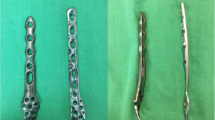Abstract
Purpose
The reduction of periosteal compression through the use of a locking plate may minimize disturbances of bone blood supply and may improve the rate of bone union. A single-centre, assessor blinded randomized controlled trial was conducted to compare the clinical effectiveness of a locking plate and a non-locking plate.
Methods
A total of 52 patients with AO/OTA 44B lateral malleolar fractures were included in this study. All patients underwent surgical fixation using a lag screw and neutralization plate. An identical treatment protocol was used in all patients, with exception of plate selection. The rate of radiographic bone union, defined as the complete disappearance of fracture lines confirmed through anteroposterior, lateral, and internal oblique views was compared at three, six, and 12 months following surgery. In addition, the Medical Outcomes 36-Item Short-Form Health Survey (SF-36) score, the time required for resolution of tenderness at the fracture site and the complication rate were evaluated.
Results
Twenty-three patients were randomly assigned to undergo fixation using a locking plate, and 29 patients were assigned to undergo fixation using a non-locking plate. Intention-to-treat analysis showed no difference in the radiographic bone union rate of fibula, SF-36 score, the time for resolution of tenderness at the fracture site and complication rates.
Conclusion
No differences were observed in patients with AO/OTA 44B lateral malleolar fractures undergoing fixation with a locking versus non-locking neutralization plate.



Similar content being viewed by others
References
Wagner M (2003) General principles for the clinical use of the LCP. Injury 34:S21–42
Perren SM (2002) Evolution of the internal fixation of long bone fractures. The scientific basis of biological internal fixation: Choosing a new balance between stability and biology. J Bone Joint Surg Br 84:1093–1110
Jöckel JA, Erhardt J, Vincenti M, Reissig J, Hoffmann R, Husain B, Täger G, Partenheimer A, Lill H, Gebhard F, Röderer G (2013) Minimally invasive and open surgical treatment of proximal tibia fractures using a polyaxial locking plate system: A prospective multi-centre study. Int Orthop 37:701–708
Uhthoff HK, Poitras P, Backman DS (2006) Internal plate fixation of fractures: Short history and recent developments. J Orthop Sci 11:118–126
Leung F, Chow SP (2003) A prospective, randomized trial comparing the limited contact dynamic compression plate with the point contact fixator for forearm fractures. J Bone Joint Surg Am 85:2343–2348
Koshimune M, Kamano M, Takamatsu K, Ohashi H (2005) A randomized comparison of locking and non-locking palmar plating for unstable Colles’ fractures in the elderly. J Hand Surg Br 30:499–503
Smith WR, Ziran BH, Anglen JO, Stahel PF (2007) Locking plates: Tips and tricks. J Bone Joint Surg Am 89:2298–2307
Fridberg M, Ban I, Issa Z, Krasheninnikoff M, Troelsen A (2013) Locking plate osteosynthesis of clavicle fractures: Complication and reoperation rates in one hundred and five consecutive cases. Int Orthop 37:689–692
Joeris A, Audigé L, Ziebarth K, Slongo T (2012) The locking compression paediatric hip plate: Technical guide and critical analysis. Int Orthop 36:2299–2306
Nikolaou VS, Tan HB, Haidukewych G, Kanakaris N, Giannoudis PV (2011) Proximal tibial fractures: Early experience using polyaxial locking-plate technology. Int Orthop 35:1215–1221
Gupta RK, Rohilla RK, Sangwan K, Singh V, Walia S (2010) Locking plate fixation in distal metaphyseal tibial fractures: Series of 79 patients. Int Orthop 34:1285–1290
Fracture and Dislocation Compendium (1996) Orthopaedic trauma association committee for coding and classification. J Orthop Trauma 10:1–154
Kim T, Ayturk UM, Haskell A, Miclau T, Puttlitz CM (2007) Fixation of osteoporotic distal fibula fractures: A biomechanical comparison of locking versus conventional plates. J Foot Ankle Surg 46:2–6
Cotton FJ (1910) Fractures and Joint Dislocations. WB Saunders, Philadelphia, p 549
Fukuhara S, Bito S, Green J, Hsiao A, Kurokawa K (1998) Translation, adaptation, and validation of the SF-36 Health Survey for use in Japan. J Clin Epidemiol 51:1037–1044
Fukuhara S, Ware JE Jr, Kosinski M, Wada S, Gandek B (1998) Psychometric and clinical tests of validity of the Japanese SF-36 Health Survey. J Clin Epidemiol 51:1045–1053
Corrales LA, Morshed S, Bhandari M, Micau T III (2008) Variability in the assessment of fracture-healing in orthopaedic trauma studies. J Bone Joint Surg Am 90:1862–1868
Takemoto RC, Sugi MT, Kummer F, Koval KJ, Egol KA (2012) The effects of locked and unlocked neutralization plates on load bearing of fractures fixed with a lag screw. J Orthop Trauma 26:519–522
Schepers T, Van Lieshout EM, De Vries MR, Van der Elst M (2011) Increased rates of wound complications with locking plates in distal fibular fractures. Injury 42:1125–1129
Acknowledgments
The authors thank Dr. Toshio Maeda for his helpful advice and suggestions.
Conflict of interest
All authors declare no conflict of interest and no funding was received for this study.
Author information
Authors and Affiliations
Corresponding author
Rights and permissions
About this article
Cite this article
Tsukada, S., Otsuji, M., Shiozaki, A. et al. Locking versus non-locking neutralization plates for treatment of lateral malleolar fractures: a randomized controlled trial. International Orthopaedics (SICOT) 37, 2451–2456 (2013). https://doi.org/10.1007/s00264-013-2109-9
Received:
Accepted:
Published:
Issue Date:
DOI: https://doi.org/10.1007/s00264-013-2109-9




